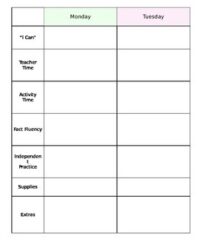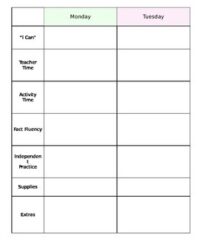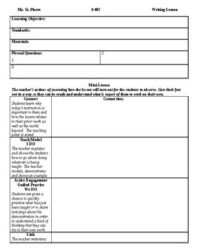Stepping into the modern classroom, you’ll often find a dynamic, student-centered environment where learning isn’t just about absorbing information but actively constructing understanding. This is where the workshop model truly shines, transforming traditional lessons into engaging, interactive experiences. It’s a powerful framework that empowers students, fosters independence, and allows teachers to provide targeted support precisely when and where it’s needed.
But even the most innovative teaching approach benefits from solid planning. To truly harness the power of the workshop model and ensure every minute in your classroom is purposeful, you need a clear, adaptable guide. That’s exactly where a well-designed workshop model lesson plan template comes into play, providing the structure you need without stifling the creativity and responsiveness that makes this model so effective.
Understanding the Core Components of a Workshop Model
At its heart, the workshop model is designed to move students from passive recipients to active participants. Imagine a structured journey that begins with a brief, focused whole-group lesson, transitions into robust independent or small-group work, and culminates in a reflective share-out. This predictable structure creates a sense of routine for students, helping them internalize the flow of learning and manage their time effectively.
The journey kicks off with the “Mini-Lesson.” This isn’t your traditional long lecture; it’s a concise, focused instruction lasting usually 5-15 minutes, aimed at teaching one specific strategy, skill, or concept. It’s designed to be immediately applicable to the independent work students will undertake. Think of it as a clear demonstration or explanation that sets the stage for the deep learning to follow, making sure everyone has a common starting point.
Following the mini-lesson, the classroom transforms into a hive of activity during the “Independent Work” phase. This is the bulk of the lesson, where students apply what they’ve learned, often with choice in how they practice or what materials they use. During this time, the teacher is not static; instead, they circulate, confer with individual students, pull small groups for targeted instruction, and assess progress. It’s a period of differentiated support and personalized learning, where every student can engage at their own pace and level.
Finally, the lesson concludes with the “Share” component. This is a crucial time for students to reflect on their learning, articulate their strategies, and learn from their peers. Whether it’s a quick whole-group debrief, partner sharing, or a short presentation of work, the share allows students to consolidate their understanding, celebrate achievements, and identify next steps. It reinforces the idea that learning is a communal experience, where insights gained by one can benefit many.
Why a Template Matters for This Dynamic Approach
Even with its flexible nature, a structured workshop model lesson plan template is indispensable. It ensures consistency, helps you cover essential standards, and provides a clear roadmap for both you and your students. Without it, the dynamic nature could lead to disorganization or missed opportunities for targeted instruction.
- Clarity and Focus: Keeps the lesson’s objective central and guides the mini-lesson directly to it.
- Time Management: Helps allocate appropriate time for each phase, preventing mini-lessons from running too long or independent work from becoming aimless.
- Differentiation Planning: Provides designated space to plan for small groups, individual conferences, and varied student needs.
- Reflection and Refinement: Offers a consistent format for post-lesson notes, aiding in future lesson improvements.
Key Elements Your Template Should Include
- Lesson Title and Subject
- Learning Objectives/Standards Addressed
- Materials Needed
- Mini-Lesson Plan (Topic, Teaching Point, Modeling/Demonstration)
- Independent Work Plan (Student Task, Differentiated Groups/Conferences, Assessment Strategy)
- Share Plan (Reflection Prompt, Student Examples, Next Steps)
- Notes/Reflection Section
Crafting Your Perfect Workshop Model Lesson Plan Template
While a general workshop model lesson plan template provides an excellent foundation, the real magic happens when you customize it to fit your specific classroom, students, and subject matter. Think of it not as a rigid form to be filled out, but as a living document that evolves with your teaching practice. The beauty of the workshop model is its adaptability, and your template should mirror that flexibility, allowing you to quickly jot down ideas, pivot based on student needs, and keep your overall instructional goals in view.
Consider the nuances of your discipline. A template for a writing workshop might emphasize stages of the writing process, while one for a math workshop could highlight problem-solving strategies and opportunities for concept application. Regardless of the subject, ensure your template prompts you to consider how you’ll assess student understanding throughout each phase, not just at the end. This continuous formative assessment is a hallmark of effective workshop teaching and helps you tailor your immediate instruction.
Remember that the best templates are those that are practical for you to use daily. It’s about striking a balance between providing enough detail to ensure purposeful instruction and remaining concise enough that planning doesn’t become overly burdensome. Experiment with different layouts and sections until you find what truly streamlines your planning process and allows you to focus more energy on your students and less on paperwork.
- Start Simple: Don’t overload your initial template. Begin with the core components and add sections as you identify specific needs.
- Be Specific with Objectives: Clear learning objectives drive every part of your workshop. Ensure they are measurable and student-friendly.
- Plan for Engagement: Think about how you’ll hook students during the mini-lesson and sustain their motivation during independent work.
- Allocate Time Realistically: Be honest about how long each segment will take. Over-planning can lead to rushing or cutting essential components.
- Build in Flexibility: Leave space for notes on student responses or unexpected teaching moments that might require a deviation from your original plan.
- Review and Revise: After using your template, take a moment to reflect. What worked well? What could be improved? Adjust your template accordingly for future lessons.
Embracing the workshop model can truly revolutionize your teaching, fostering a classroom where students are deeply engaged, empowered, and reflective learners. By utilizing a thoughtful and adaptable lesson planning tool, you can ensure that this dynamic approach is implemented with precision and purpose. It’s about building a robust framework that supports both your instructional goals and your students’ diverse learning journeys, making every minute count.
Ultimately, a well-structured plan allows you to step into your classroom with confidence, ready to facilitate meaningful interactions and guide genuine discovery. It’s an investment in effective teaching, empowering you to create vibrant learning experiences that resonate long after the lesson ends, nurturing independent thinkers ready for their next challenge.


